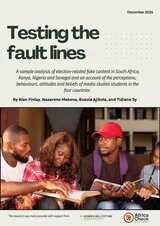Testing the fault lines
Wahlbezogene Desinformationen verändern die Demokratien in ganz Afrika. Testing the Fault Lines untersucht, wie gefälschte Inhalte, die während der Wahlen in Südafrika, Kenia, Nigeria und Senegal verbreitet werden, das Misstrauen schüren, Spaltungen ausnutzen und die öffentliche Wahrnehmung verzerren.
Diese Studie untersucht, wie Studierende der Medienwissenschaften mit falschen Informationen umgehen, und zeigt, dass Medienkompetenz zwar hilfreich ist, die Anfälligkeit jedoch vom nationalen Kontext und dem Geschlecht abhängt. Von gefälschten Videos bis hin zu nachgemachten Medien werden Desinformationen so gestaltet, dass sie glaubwürdig erscheinen und sich schnell verbreiten.
Kann digitale Kompetenz ihre Auswirkungen verhindern? Testing the Fault Lines deckt die Taktiken hinter Wahlfehlinformationen und ihre Risiken für die Demokratie auf.
Produktdetails
Inhaltsverzeichnis
Executive Summary
- Introduction
- Objective of study
- Research group
- Research methods
4.1 Sample content analysis
4.2 Focus group sessions
4.2.1. Student participants
4.2.2. Questionnaire
4.2.3. Focus group discussions
4.3 Interviews - Country profiles
5.1. South Africa
5.2. Kenya
5.3. Nigeria
5.4. Senegal - Analysis of election-related fake content
6.1. South Africa: the 2024 national and provincial elections
6.1.1. Content categories
6.1.2. Content types
6.2. Kenya: The 2022 general elections
6.2.1. Content categories
6.2.2. Content types
6.3. Nigeria: The 2023 general elections
6.3.1. Content categories
6.3.2. Content types
6.4. Senegal: The 2024 presidential elections
6.4.1. Content categories
6.4.2. Content types - Findings of focus group sessions
7.1. Political, information and trust environments
7.1.1. Perception of political environment
7.1.2. Enagement in political environment
7.1.3. Reliability of information environment
7.1.4. Trust environment
7.2. Social media use and sharing behaviours
7.2.1. Carefulness of sharing information
7.2.2. Correcting others online
7.3. Attitudes to forwarding election-related fake content
7.4. Credulity: An account of the tendency of students to believe fake content
7.4.1. Responses by gender
7.4.2. Responses by country and year of study
7.4.3. Testing belief in common disinformation narratives - Discussion of findings
- Conclusion
- Appendix
